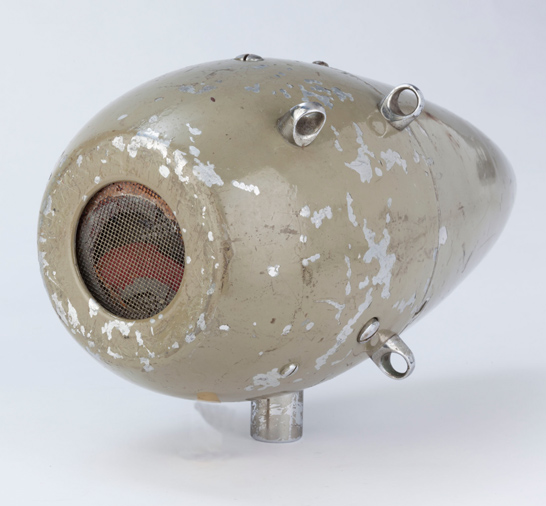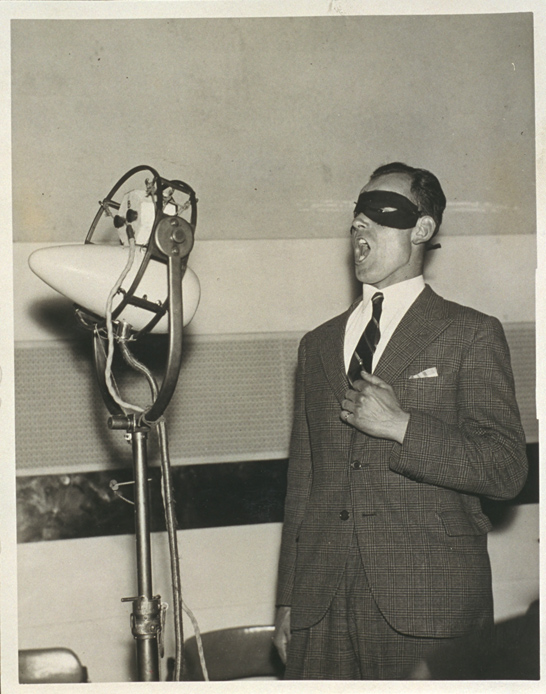
We acquired two examples in 2012 as part of the BBC Collection. In use from 1931 until about 1935, it was eventually replaced by the iconic Marconi Type A ribbon microphone. A major strength of the BBC Collection is its diverse selection of over 100 broadcast-quality microphones.
How does the ‘bomb’ microphone work?
The torpedo-like case contains a single-valve amplifier, essential because of the weak audio signal produced by the insensitive condenser microphone inside.
The amplifier had been developed by BBC engineers, consisting of a cylindrical unit embodying the amplifier components, mounted in rubber sponge inside the streamlined aluminum housing.
The streamlining itself did not possess any acoustical advantage, but it enabled a neat and pleasing unit to be designed, in accordance with the acoustical requirements. The microphones were manufactured in Britain by Standard Telephones and Cables (STC), formerly Western Electric.
Condenser microphones consist of a capacitor with one plate fixed and the other forming the diaphragm which moves when soundwaves are present.

Although they are commonplace today, and the technology has been perfected, they were largely experimental at the time. The microphones could be unreliable and were subject to going noisy under even moderately humid conditions, therefore they were never used for outside broadcasts.
It was found that even the slightest trace of moisture needed to be excluded from the wiring and components of the amplifier by sealing up as much as possible of the latter in paraffin wax. In addition, the greatest care needed to be taken in the selection of the type of valve used in the amplifier.
Despite these precautions, valve noise remained a difficulty owing to the low sensitivity of the microphone itself.
One of them was installed in Studio 3B at Broadcasting House, where it was used by the Prince of Wales (later Edward VIII). A fairly accurate replica appeared in The King’s Speech (2010), but in the opening scene of the film there is an anachronism: the bomb microphone is seen in use in a BBC studio in 1925, six years before it was introduced.
The ‘bomb’ on television
Spring mounted in a frame on a movable floor stand, the ‘bomb’ became a regular fixture in the first-ever BBC television studio, located in Broadcasting House down in Studio BB (the sub-basement).
Regular television broadcasts began from this studio on 22 August 1932 using John Logie Baird’s (my grandfather’s) 30-line system.
These were semi-experimental, in that the service was broadcast to a very limited number of viewers, and it was expected that in a few years, bespoke television transmitters would enable television broadcasting to move to a more advanced stage. It was the first time that television programmes had been made on a regular basis by the BBC.
The major reason that the ‘bomb’ microphone was chosen for television is that it is omni-directional—it can pick up sound from all directions. This allowed early 1930s television performers to move around in the studio freely without constantly worrying about drifting out of the range of the microphone.
It was awkward to move the microphone while a performance was in progress, so the positioning of it prior to the beginning of the television programme was quite critical.
Once the programme began, the television studio was almost completely dark, because the studio operated on the ‘flying spot’ system.
In this system, a narrow beam of light would scan across the scene, and the reflections would be picked up by photo-electric cells on the studio wall.
Because it was so dark, during a visit to the studio by the American composer Irving Berlin (1888–1989), the recently-appointed leader of the BBC Dance Orchestra Henry Hall (1898–1989) accidentally damaged one of the ‘bomb’ microphones. Standing before the screen he sang one of Irving’s songs, and he was moved by the chorus to try a step dance. He caught his foot in one of the cables, the microphone stand fell over, cracking the aluminium housing on the microphone.
In February 1934 the BBC decided to move television out of Broadcasting House to a larger studio at 16 Portland Place where the low-definition 30 line broadcasts continued, with the ‘bomb’ microphone still being used for sound. Studio BB was then used by Henry Hall and the BBC Dance Orchestra.
Interesting to see the Marconi Reisz carbon mic mounted above the mighty STC. I wonder if this was the back up?
It’s possible that it was a back-up since the condenser mic could malfunction if any moisture was present.
It is also possible that they were mixing both microphones to try to get a cardiod (heart-shaped) sensitivity pattern, as was done a few years later in the STC 4033A boom mic.
The 4033A contained an omni directional carbon mic, and ribbon mic which had a polar (figure 8) sensitivity pattern. Mixing the two made this microphone cardiod, (minimising background noise).
– Iain
It’s a thought, but I don’t think that mixing these two together would change the polar pattern as they both appear to be omnis! (omni+omni= omni )
The 4033A is indeed an interesting microphone but…… the omni capusle is a dynamic and not a carbon element as you suggest. I own a number of STC mics which can be found on my blog along with links to audio recordings.
http://martinmitchellsmicrophones.wordpress.com/
________________________________
The back-up is still the best theory. Possibly the sensitivity or sonic difference. Yes – it is a moving coil not a carbon in the 4033A.
Even though this article speaks of the insensitivity of condenser microphones, these were the most sensitive types available.
This was probably the reason why the BBC used them in the studio, not the omni directional recording pattern, since all microphones of that period were omni’s.
I’d be very interested to see a picture of the amplifier in this mic and a circuit diagram. I’ve never been able to find anything about it in BBC technical literature.
Hello gentlemen hello Martin we’ve recently spoke via email. So I have a BBC Marconi tube condenser microphone from 1934 the experimental microphone I found it here in the United States in the trash of of a gentleman who was a producer and news anchor for ABC News in America for many many years. I only yesterday posted it on eBay because I have not been able to find anyone who knew anything about it only to amazingly run into Martin if you guys want to take a peek at it it is listed on eBay under 1934 Marconi Marconi tube condenser microphone I’m learning a lot about this stuff you guys have a good day if you want pictures and you can’t find it on eBay just email me at jeffro4226@gmail.com there are six days left on the eBay auction if you know anyone interested please direct them there as I want this to fall into the proper hands. I cannot pull it from eBay and keep a good reputation as a seller. Hopefully someone from the museum or a friend of the museum can get the microphone and then donate it. Martin thank you again for all of your input and expertise
I have since written a detailed article about this type of microphone that should clear up some of the controversy, now published on the Baird family website (I left the museum in 2016). You can find it here. https://www.bairdtelevision.com/the-bbc-stc-bomb-condenser-microphone.html